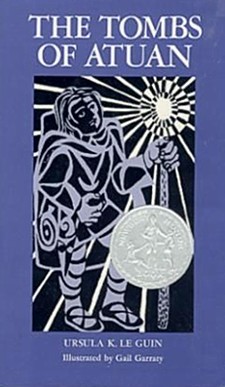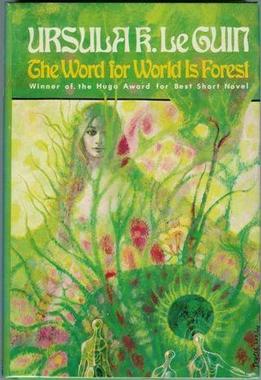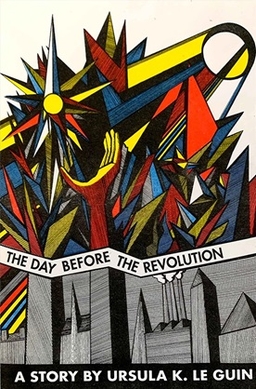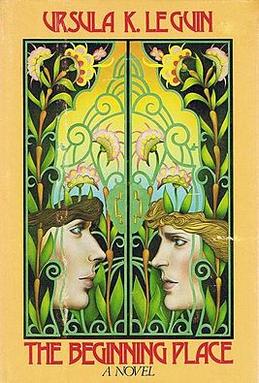Related Research Articles

Ursula Kroeber Le Guin was an American author. She wrote works of speculative fiction, including science fiction works set in her Hainish universe, and the Earthsea fantasy series. Her work was first published in 1959, and her literary career spanned nearly sixty years, producing more than twenty novels and over a hundred short stories, in addition to poetry, literary criticism, translations, and children's books. Frequently described as an author of science fiction, Le Guin has also been called a "major voice in American Letters". Le Guin said she would prefer to be known as an "American novelist".

The Dispossessed is a 1974 utopian science fiction novel by American writer Ursula K. Le Guin, one of her seven Hainish Cycle novels. It is one of a small number of books to win all three Hugo, Locus and Nebula Awards for Best Novel. It achieved a degree of literary recognition unusual for science fiction due to its exploration of themes such as anarchism and revolutionary societies, capitalism, utopia, individualism, and collectivism.

"The Ones Who Walk Away from Omelas" is a 1973 short work of philosophical fiction by American writer Ursula K. Le Guin. With deliberately both vague and vivid descriptions, the narrator depicts a summer festival in the utopian city of Omelas, whose prosperity depends on the perpetual misery of a single child. "The Ones Who Walk Away from Omelas" was nominated for the Locus Award for Best Short Fiction in 1974 and won the Hugo Award for Best Short Story in 1974.

The Tombs of Atuan is a fantasy novel by the American author Ursula K. Le Guin, first published in the Winter 1970 issue of Worlds of Fantasy, and published as a book by Atheneum Books in 1971. It is the second book in the Earthsea series after A Wizard of Earthsea (1969). The Tombs of Atuan was a Newbery Honor Book in 1972.

The Earthsea Cycle, also known as Earthsea, is a series of high fantasy books written by the American author Ursula K. Le Guin. Beginning with A Wizard of Earthsea (1968), The Tombs of Atuan, (1970) and The Farthest Shore (1972), the series was continued in Tehanu (1990), and Tales from Earthsea and The Other Wind. In 2018, all the novels and short stories were published in a single volume, The Books of Earthsea: The Complete Illustrated Edition, with artwork by Charles Vess.

Rocannon's World is a science fiction novel by American writer Ursula K. Le Guin, her literary debut. It was published in 1966 as an Ace Double, along with Avram Davidson's The Kar-Chee Reign, following the tête-bêche format. Though it is one of Le Guin's many works set in the universe of the technological Hainish Cycle, the story itself has many elements of heroic fantasy. The hero Gaveral Rocannon encounters lords who live in castles and wield swords, and other races much like fairies and gnomes, in his travels on a backward planet.

Planet of Exile is a 1966 science fiction novel by American writer Ursula K. Le Guin, part of her Hainish Cycle. It was first published as an Ace Double following the tête-bêche format, bundled with Mankind Under the Leash by Thomas M. Disch. In 2017, the rights for a movie were acquired by Los Angeles Media Fund.
City of Illusions is a 1967 science fiction novel by American writer Ursula K. Le Guin. It is set on Earth in the distant future, and is part of her Hainish Cycle. City of Illusions lays the foundation for the Hainish cycle which is a fictional universe in which the majority of Ursula K. Le Guin's science fiction novels take place.
"The Rule of Names" is a short story by American writer Ursula K. Le Guin, first published in the April 1964 issue of Fantastic and reprinted in collections such as The Wind's Twelve Quarters. This story and "The Word of Unbinding" convey Le Guin's initial concepts for the Earthsea realm, most importantly its places and physical manifestation. Most of the characters from the novels do not make an appearance, with the exception of the dragon Yevaud. Both stories help explain the foundations of the Earthsea realm, in particular the importance of true names to magic.
"The Word of Unbinding" is a short story by American writer Ursula K. Le Guin, first published in the January 1964 issue of Fantastic, and reprinted in collections such as The Wind's Twelve Quarters. In this story, the Earthsea realm, which was later made famous by A Wizard of Earthsea, was first introduced. Along with the story "The Rule of Names", this story conveys Le Guin's initial concepts for the Earthsea realm, most importantly its places and physical manifestation, but not the characters appearing in the novels.

The Wind's Twelve Quarters is a collection of short stories by American writer Ursula K. Le Guin, named after a line from A. E. Housman's A Shropshire Lad, and first published by Harper & Row in 1975. A retrospective of Le Guin's short stories, it collects 17 previously published pieces of speculative fiction. Four of these were the germs of novels she was to write later, and a few others shared connections to Le Guin novels. At least four stories are set in the Hainish Universe, and two others in Earthsea. Many stories share themes and motifs, including time and utopia: certain images and characters also recur, including isolated scholars or explorers seeking knowledge in a hostile world.

The Word for World Is Forest is a science fiction novella by American writer Ursula K. Le Guin, first published in the United States in 1972 as a part of the anthology Again, Dangerous Visions, and published as a separate book in 1976 by Berkley Books. It is part of Le Guin's Hainish Cycle.

"The Day Before the Revolution" is a science fiction short story by American writer Ursula K. Le Guin. First published in the science fiction magazine Galaxy in August 1974, it was anthologized in Le Guin's 1975 collection The Wind's Twelve Quarters and in several subsequent collections. Set in Le Guin's fictional Hainish universe, the story has strong connections to her novel The Dispossessed, and is sometimes referred to as a prologue to the longer work, though it was written later.

The Beginning Place is a short novel by American writer Ursula K. Le Guin, written in 1980. It was subsequently published under the title Threshold in 1986. The story's genre is a mixture of realism and fantasy literature. The novel's epigraph "What river is this through which the Ganges flows?" is quoted from Jorge Luis Borges. The novel has been subject to critical studies comparing it to C.S. Lewis' The Chronicles of Narnia, Lewis Carroll's Through the Looking-Glass and William Shakespeare's As You Like It.

The Left Hand of Darkness is a science fiction novel by the American writer Ursula K. Le Guin. Published in 1969, it became immensely popular, and established Le Guin's status as a major author of science fiction. The novel is set in the fictional Hainish universe as part of the Hainish Cycle, a series of novels and short stories by Le Guin, which she introduced in the 1964 short story "The Dowry of Angyar". It was fourth in sequence of writing among the Hainish novels, preceded by City of Illusions, and followed by The Word for World Is Forest.

Ursula K. Le Guin (1929–2018) was an American author of speculative fiction, realistic fiction, non-fiction, screenplays, librettos, essays, poetry, speeches, translations, literary critiques, chapbooks, and children's fiction. She was primarily known for her works of speculative fiction. These include works set in the fictional world of Earthsea, stories in the Hainish Cycle, and standalone novels and short stories. Though frequently referred to as an author of science fiction, critics have described her work as being difficult to classify.
The anthropologist Leon E. Stover says of science fiction's relationship to anthropology: "Anthropological science fiction enjoys the philosophical luxury of providing answers to the question "What is man?" while anthropology the science is still learning how to frame it". The editors of a collection of anthropological SF stories observed:
Anthropology is the science of man. It tells the story from ape-man to spaceman, attempting to describe in detail all the epochs of this continuing history. Writers of fiction, and in particular science fiction, peer over the anthropologists' shoulders as the discoveries are made, then utilize the material in fictional works. Where the scientist must speculate reservedly from known fact and make a small leap into the unknown, the writer is free to soar high on the wings of fancy.

"Coming of Age in Karhide" is a science fiction short story by Ursula K. Le Guin, first published in 1995. The story is set on the fictional planet of Gethen, the same as Le Guin's 1969 novel The Left Hand of Darkness, and is a part of Le Guin's Hainish cycle. The story explores themes of growing into adulthood on a planet where individuals have no fixed gender identity. Reviewers stated that the story went further than Left Hand in its exploration of gender and sexuality, and was a "quietly feminist" work. It was also described as lacking the "dizzying impact" of Left Hand. In 2002, it was anthologized in the volume The Birthday of the World, along with many other stories exploring marriage and sexual relationships.
"Vaster than Empires and More Slow" is a science fiction story by American author Ursula K. Le Guin, first published in the collection New Dimensions 1, edited by Robert Silverberg. It is set in the fictional Hainish universe, where Earth is a member of an interstellar "League of Worlds". The anthology was released in United States in 1971, by Doubleday Books.
"The Dowry of Angyar" is a science fiction short story by American writer Ursula K. Le Guin, first published in 1964. It is the first work of the Hainish Cycle. The story is set on a fictional planet of the star Fomalhaut, and follows a highborn woman as she tries to track down a family heirloom. It was framed by commentary from ethnologists studying the intelligent life-forms of the Fomalhaut system. The story drew from Norse mythology, including the legend of the Brísingamen, and explored the concept of time dilation. "The Dowry of Angyar" drew comments for its stylistic devices, while a review praised Le Guin's writing as "crystalline prose". It was later used as the prologue to Le Guin's 1966 novel Rocannon's World. In later publications, including in the 1975 anthology The Wind's Twelve Quarters, the story was given the title "Semley's Necklace".
References
- ↑ Spivack, Charlotte, Ursula K. Le Guin, (Boston: Twayne Publishers, 1984), page 50.
- ↑ Le Guin, Ursula, The Wind's Twelve Quarters, (New York, Harper & Row, October 1975), story introduction.
- ↑ Spivack, Charlotte, Ursula K. Le Guin, (Boston: Twayne Publishers, 1984), page 48.
- ↑ Wood, Susan, Ursula K. Le Guin, (New York:Chelsea House, 1986), page 186.
- ↑ Barbour, Douglas (March 6, 1976). "Women Prove Science Fiction's Alive and Healthy". Toronto Star. Retrieved October 30, 2023.